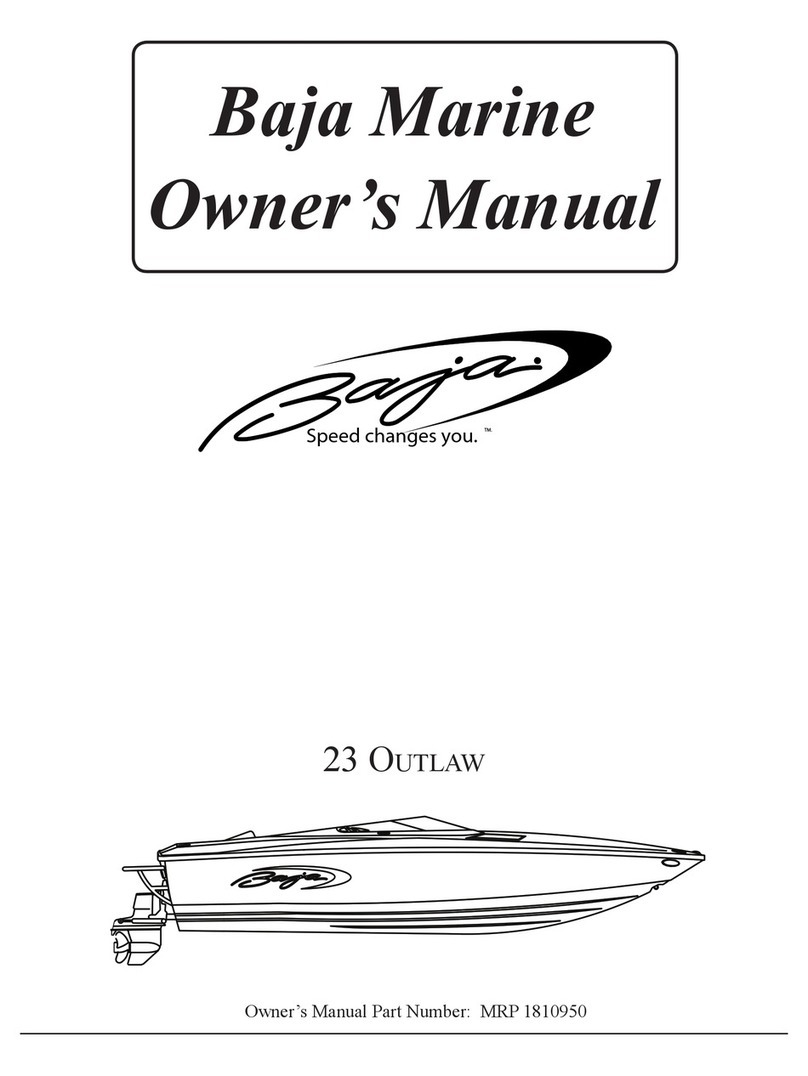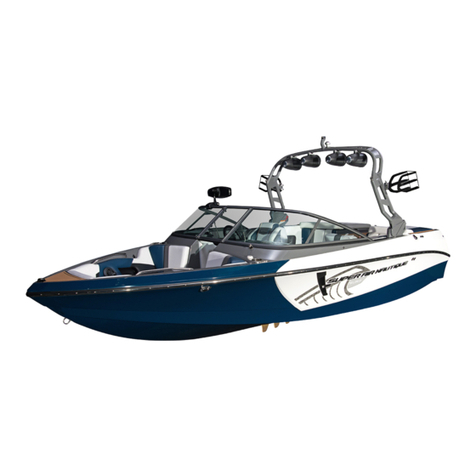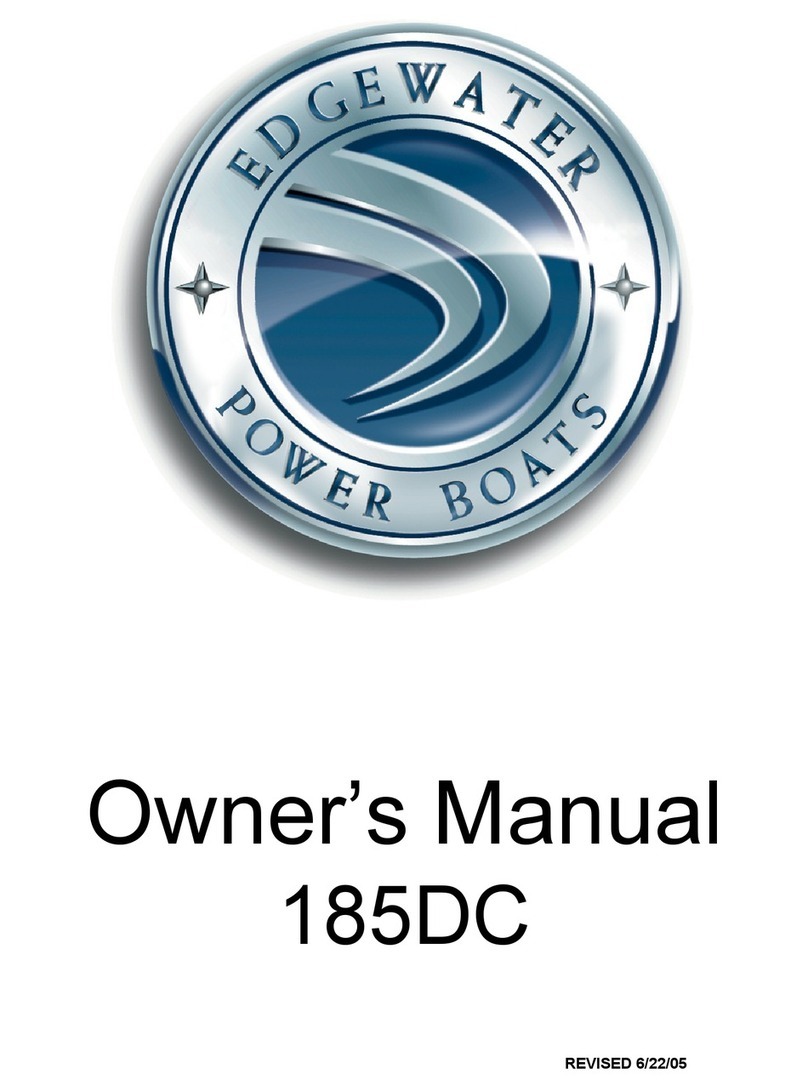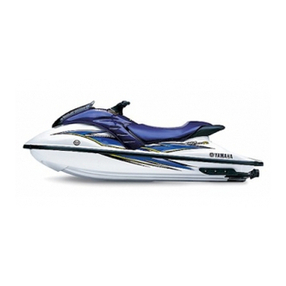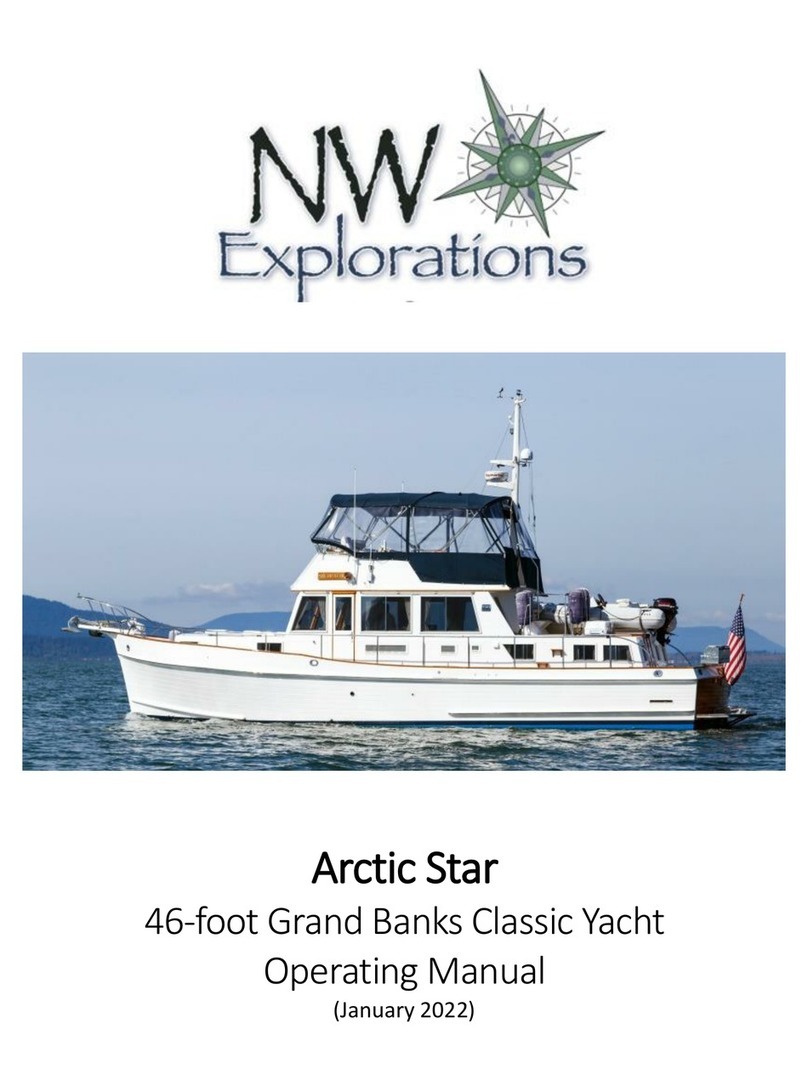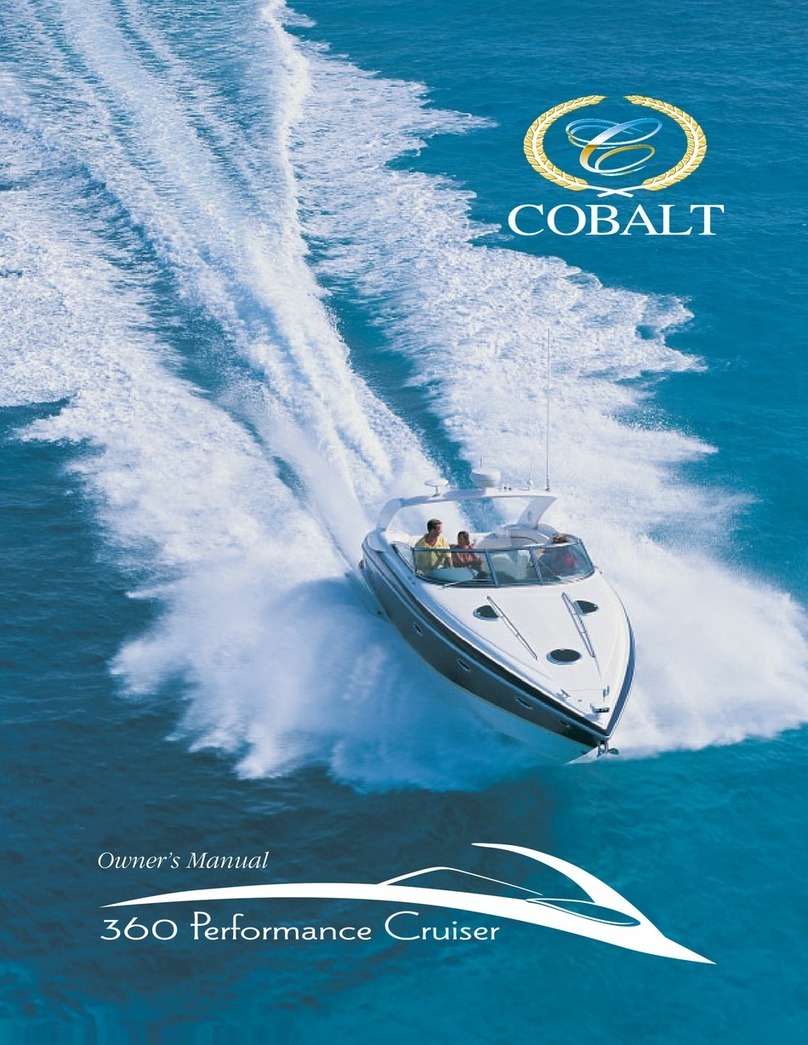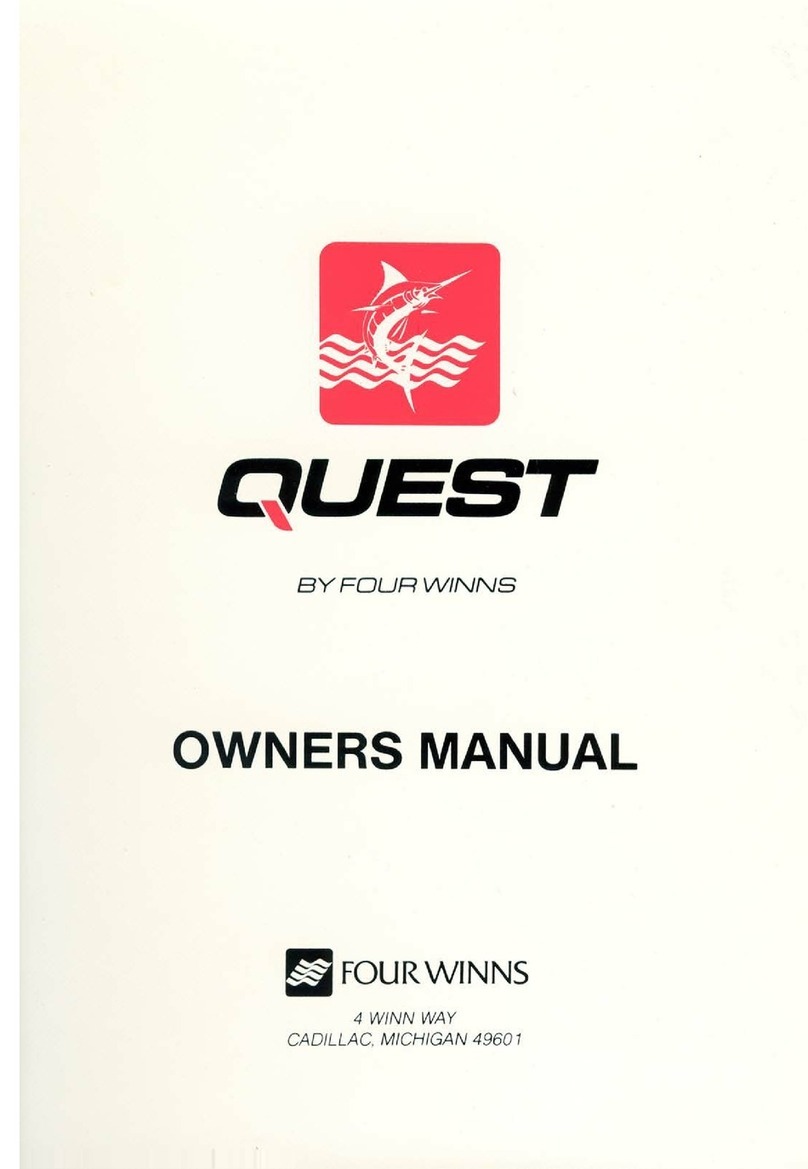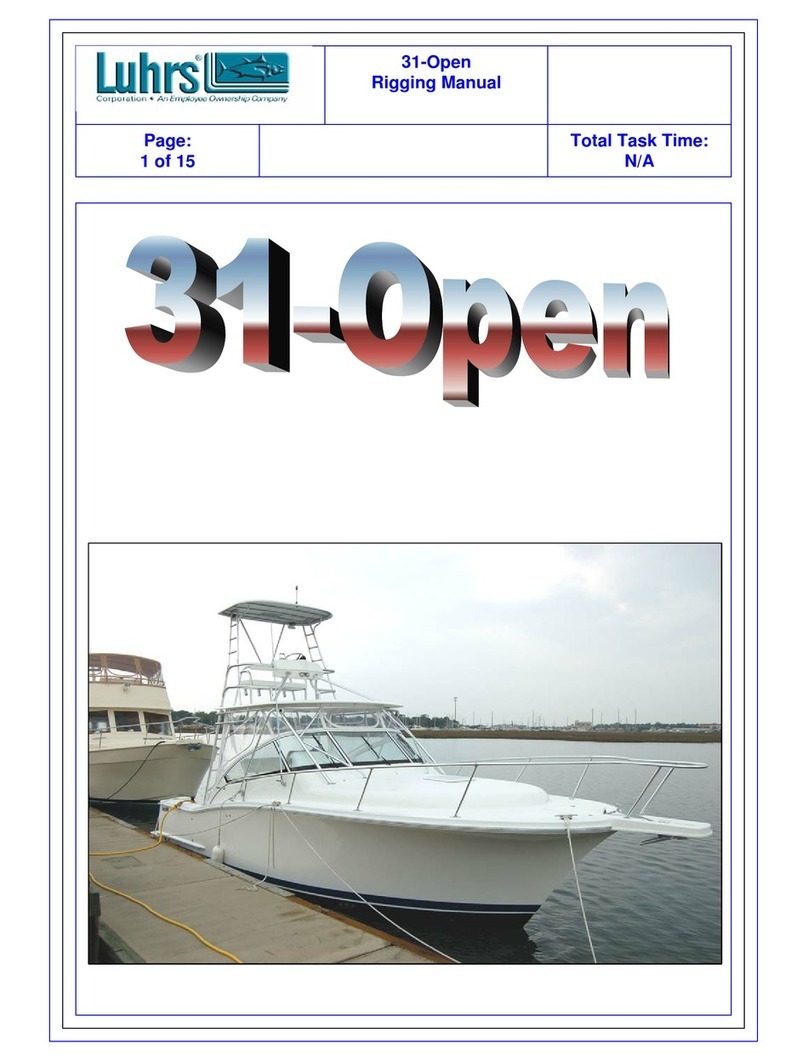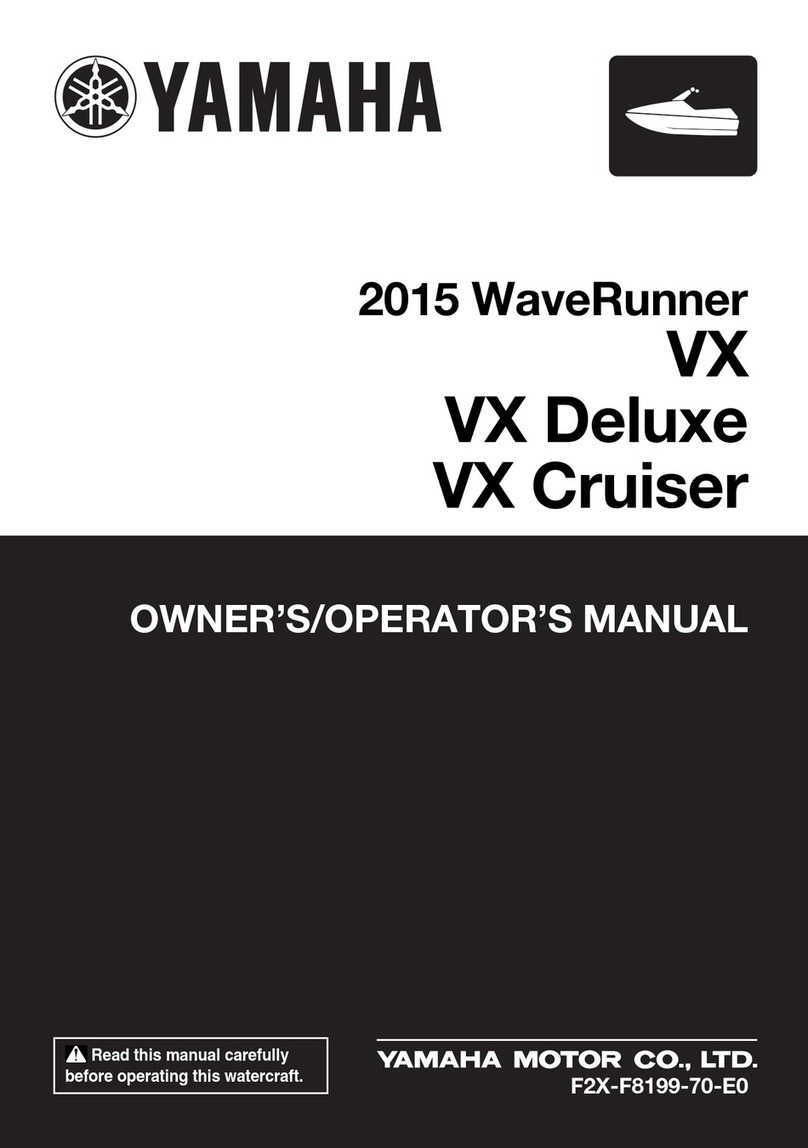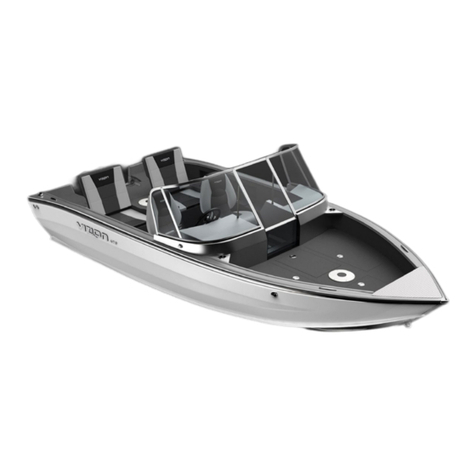Rondar K6 User manual

OWNER’S MANUAL
147 Summit, Building 3, Unit 2. Peabody, MA, 01960
Tel. 855.RONDAR.1(855-766-3271)
WWW.RONDARBOATS.COM

INTRODUCTION
Congratulations on the purchase of your new K6 and thank you for choosing our
boat. We are confident that you will have many hours of great sailing and racing in
this truly excellent design.
Important note
The K6 is an exciting boat to sail and offers fantastic performance. It is a light
weight racing boat and should be treated with care. In order to get the most
enjoyment from your boat and maintain it in top condition, please read this
manual carefully.
Whilst your boat has been carefully prepared, it is important that new owners should
check that shackles, knots and mast step bolts etc. are tight. This is especially
important when the boat is new, as travelling can loosen seemingly tight fittings and
knots. It is also important to regularly check such items prior to sailing. Make sure
that you have a basic tool kit with you the first time you rig the boat in case there are
tuning / settings changes that you wish to make.
Contents
DECLARATION OF CONFORMITY
NOTICE OF STANDARDS USED
CERTIFICATE OF CONSTRUCTION – TRAILER
RIGGING INSTRUCTIONS
TUNING AND SAILING TIPS
CARE AND MAINTENANCE
K- BOATS TERMS OF BUSINESS
K6 CLASS ASSOCIATION
For further information, spares and accessories, please contact your local
dealer, or Rondar Raceboats direct.
Your K6 has been supplied by;

EC DECLARATION OF CONFORMITY TO DIRECTIVE 94/25/CE
I declare that the craft describes as :
K 6
bearing the Hull Identification Number :
HIN ;
Trade marque : Rondar Raceboats Ltd.
Type : K 6 Keelboat
Design Category : C - INSHORE
Inspection module used : MODULE A - INTERNAL PRODUCTION CONTROL
Stability and Bouyancy test To ISO 12217 by RYA.
Maximum crew : 4 + Baggage ( 340KG)
ISO standards used: ISO 12217
Overall length : 5.81 m
Beam : 1.97 m
Sail Area : 19.7 m2
Builder’s name : Rondar Raceboats
Date : __________________
Signature : _______________________ Paul Young.
G
B
R
K
B

NOTICE OF STANDARDS USED FOR ESSENTIAL REQUIREMENTS OF RCD.
REQUIREMENT STANDARD USED
1. BOAT DESIGN CATEGORY - RSG GUIDELINES
2.1 HULL IDENTIFICATION ISO 100087
2.2 BUILDERS PLATE ISO 14945
2.3 PROTECTION FROM FALLING OVERBOARD ISO 15085
2.4 VISIBILITY FROM MAIN STEERING POSITION N/A
2.5 OWNERS MANUAL ISO 10240
3.1 INTEGRITY AND STRUCTURAL REQUIREMENTS RSG GUIDELNES +
TESTING
3.2 STABILITY AND FREEBOARD ISO 12217
3.3 BOUYANCY AND FLOTATION ISO 12217
3.4 OPENINGS IN DECK AND SUPERSTRUCTURE RSG GUIDELNES + ISO
12217
3.5 FLOODING ISO 11812 + ISO 12217
3.6 MANUFACTURER’S MAXIMUM RECOMMENDED LOAD ISO 14946
3.7 LIFERAFT STOWAGE N/A
3.8 ESCAPE N/A
3.9 ANCHORING, MOORING, AND TOWING ISO 15084
4 HANDLING CHARACTERISTICS N/A
5 INSTALLATIONS N/A
F INSPECTION OF COMPONENTS N/A
G CONFORMITY ASSESSMENT MODULES USED MODULE A – INTERNAL
PRODUCTION CONTROL
H TECHNICAL DOCUMENTATION RSG GUIDELINES
Note;
RSG Guidelines are used where applicable.

CERTIFICATE OF CONSTRUCTION
K6 ROAD TRAILER AND TROLLEY
COMBINATION
CHASSIS NO:
DATE MANUFACTURED:
MAX GROSS WEIGHT: 600 Kgs
MAX LOAD: 400 Kgs
TYRES: 145 x 10 x 4 Ply E11 Tyres
TYRE PRESSURE: 31 PSI
TYRE BAR: 2.15
SUSPENSION: Bramber 600kg Independent Rubber
Suspension Units
BRAKES: N/A
HITCH: Alko Kober 40sq unbraked coupling
Chassis galvanized to BS 729
Signed on behalf of Bramber Trailers………………………………………………………

RIGGING INSTRUCTIONS
Stepping the mast
1). Ensure that the halyards are positioned so the ends can be reached once the
mast has been stepped.
2). Stand up the mast next to the boat, adjacent to the mast gate. One person
should stand in the boat and lift the mast into place, taking care when
lowering it through the gate in the deck and down into the mast step. Ensure
the heel is properly located in the mast step. It helps to ensure that the mast
step is clear of ropes before you start to lift the mast into position, and that the
deck control rope is loosened off. When stepped, visually check that the T
terminals have not become jammed into the wrong positions when stepping.
3). The rig has no forestay, so it is a good idea to attach the spinnaker halyard to
the U-bolt on the bow, and to thread the tail through the turning block and into
the cleat on the starboard side of the capping, this helps to support the mast
and prevent it falling backwards out of the step, damaging the mast gate area
of the deck.
4). Attach the main shrouds to the large aft chain plates, approximately in the
middle of the fitting (3/4 holes from the top or bottom). You may have to pull
the top of the mast towards the chain plate using the main halyard to help get
the pins through the hole.
5). Fit the lower shrouds by inserting the t-terminals on the top end through the
bracket above the gooseneck and attach the lower ends to approximately the
middle of the forward smaller chain plates. (When the mast is tensioned to a
sailing tension, the lowers should just be tight enough to limit forwards bend).
6). Connect the keel hoist rope to the stainless steel block on the purchase
system. Connect the snap shackle to the top of the keel.
Rigging the jib
7). Rotate the jib furler on the tack bar at the bow, until the furling line is fully
wound on to the drum. If you do not do this then the sail will not furl away
fully. Check that the T-terminal on the halyard is correctly positioned on the
mast.
8). Shackle the jib tack to the swivel in the tack bar. Tape the shackle to stop the
spinnaker ripping on it when hoisting or lowering the sail.
Shackle the halyard on to the head of the sail. It helps to tape the fitting here
also, and to put one layer of tape onto the swivel to stop the halyard twisting
as you hoist the jib.
Shackle the jib sheet on the clew board on the sail. Start on the middle hole.
9). Hoist the jib until the loop on the end of the wire halyard emerges from the
exit on the mast below the gooseneck. Hook on the jib halyard tensioning
purchase (which is shackled to the mast near the base) to the end of the
halyard. Pull on the rig tension using this purchase to take the slack out of the
system. About 75 kg of rig tension is sufficient for in the dinghy park and

launching or recovering the boat. If you pull on too much tension, then the jib
will not furl or unfurl easily.
10). Furl the jib by pulling the furling line on the starboard side under the aft end of
the foredeck. You will need to ensure that the jib sheet is slack.
11). Thread the mast gate control line around the front of the mast, through the
block, back around the front of the mast, pull it tight enough to limit forward
mast movement and jamb it in the cleat.
How to tune the mast before sailing.
Once the jib is hoisted and the rig tensioned, you should check the rig settings as
rigging lengths can vary and the shroud pin hole settings indicated above only give a
guideline. A good sailing tension is 150 – 180 kg measured on the jib luff wire. This is
a lot of tension and will require quite a strong pull on the tension system rope.
The mast should carry a significant amount of aft rake (approx 8350mm measured
from the mast tip to the top of the rudder gantry), which is determined by the position
of the pins through the main shrouds in the chainplates.
There should be at least 75-100mm of pre bend, which is controlled in the main part
of the mast by the spreader angle (angle the spreaders back to increase the pre
bend). Note, the spreaders are supplied in a “safe” mid range setting.
Alterations are made at the owner’s risk – moving the spreaders to extreme
forward settings may result in rig failure by the mast inverting downwind with
the spinnaker up.
The lower shrouds should allow the lower part of the mast to pre-bend. They should
not carry much tension until the mainsail has been hoisted and the kicker attached.
The lowers shrouds merely prevent excessive bend from the vang in the lower part of
the mast. Reduce tension in the lowers if they stop the mast from assuming a natural
curve from the pre-bend caused by the spreaders. Note that too much tension in
the lowers will encourage the mast to invert downwind, and this can lead to
mast failure.
N.B. The very first time you apply rig tension, you may hear some settlement
noise from the rig and hull (creaks, cracks, groans, etc.!). This is quite natural
and is because all of the separate components are “bedding in” and stretching
or moving “etc to their normal tensioned positions. After the first few sails, so
long as you stay within the parameters described above, this will stop.
Rigging the asymmetric spinnaker
12). Thread the spinnaker halyard in the following order:
From the mast, down through the block on the deck to starboard side of the
mast step, and aft through the halyard cleat on the starboard side at the front
of the keel case capping. (should be done when stepping mast see item 3)
Then, lead the halyard aft, through the block on the keel case capping,
through both holes in the centre console, and through the lead block on the
centre spine, and then through the block on the elastic take up system.

The halyard then runs forwards to the block at the aft end of the spinnaker
sock, forwards through the sock and out of the chute mouth.
13). Attach the spinnaker as follows:
Tie the rope from the forward end of the bowsprit to the tack of the spinnaker.
To ensure that the sail is not twisted, run your hands up the red luff tape on
the spinnaker until you reach the head of the sail, then tie the spinnaker
halyard on to the head of the sail.
Tie the middle of the spinnaker sheets to the clew of the sail. Lead the ends
through the ratchet blocks near the shroud plates (ensure you thread it the
correct way through the ratchets, which only work under load), and tie the
ends together.
The spinnaker halyard tail (spinnaker downhaul) comes from the chute
mouth, leads through a loop on the lower third of the spinnaker and ties onto
the webbing strop on the top third of the sail. It is a good idea to tie it on with
a long loop (say 300 mm) here, as it makes the spinnaker enter the chute
more easily when dropping.
The safest and easiest way to rig the downhaul is to pull the pole right out,
and to pull the port sheet tight into the ratchet and to cleat it off. If you then
hoist the spinnaker until the head is about 2 metres off the ground you can
then see the two attachment points on the spinnaker. You can then thread the
spinnaker downhaul up through the lower ring, and tie it to the top loop.
14). You can then pull the spinnaker into the chute by pulling on the downhaul
at the block just aft of the spinnaker sock. If the spinnaker will not stow away
completely, then check that the halyards and the sheets are un-cleated.
Rigging the mainsail
15). Velcro the clew strap around the aft end of the boom.
16). Thread the outhaul through the clew cringle and hook the end into the slot on
the end of the boom..
17). Ensure the boat is head to wind. Tie the main halyard to the head of the sail
and hoist the mainsail. Pull the halyard tight through the cleat to ensure all
slack is removed.
18). Fit the boom onto the gooseneck, and fit webbing tack strap through the hole
in the sail around mast. Tension the outhaul to sailing position.
19). Thread the tack downhaul line through the cringle above the tack and tie the
end around the gooseneck fitting.
20) Attach the vang hook to the webbing strap around the boom.

Rudder
21). The rudder blade simply slots into the rudder stock after launching and can be
lowered progressively as water depth allows.
Launching
Individual launching areas vary and common sense will determine the best order of
proceedings when launching the K6. The boat launches from it’s trolley just like a
dinghy, and can be launched from a crane hoist, slipway, shore or beach with ease.
The boat will sail with just 0.5 metres of keel down, and although it is less stable in
this mode, it will not capsize.
Option 1. The favourite option is to launch the boat from a slipway, with a convenient
pontoon nearby. Put the boat in the water once the jib and spinnaker have been
rigged. Tie it head to wind to a pontoon, lower the keel and then hoist the mainsail.
Option 2. If option 1 is not possible, rig the jib and spinnaker, launch the boat, walk it
into deep enough water to lower the keel half down, sail the boat off under jib alone,
then drop the keel and hoist the mainsail in deeper water.
Option 3. If the wind is in the right direction, it is often easier to hoist the mainsail
with the boat ashore, then launch and lower the keel half down prior to sailing away.
IMPORTANT
When you are ready to launch, pull on the keel lift purchase from behind the
block on the port side of the keel case capping, until the keel bulb has lifted
slightly from the trolley cradle. If slipway conditions are such that the boat will
float off the cradle without lifting the keel, then ensure that the keel rope is
cleated tight before launching.
The rig tension must have been applied before you lift the keel from the trolley.
Failure to do this may result in breaking the mast.
Always ensure the keel lift purchase blocks are not “capsized” and that there
is no slack or any “loops” caught in the purchase that may pull out and allow
the keel to drop unexpectedly.
Keep your fingers and feet and all ropes and controls away from the keel slot
and the top of the capping until the keel is fully lowered.
The boat will feel less than stable until the keel has been lowered at least half
way down.
22). Put the boat in the water and float it off the trolley. When in deep enough
water, lower the keel making sure the chocks on the sides at the top of the
keel guide down into the corresponding slots in the keel case.
23). Un-hook the keel hoist line and clip it to the fairlead over the mast gate control
line cleat. Take up the slack on the lift purchase.
24). Fit the velcro strap over the top of the keel, through the ring on the opposite
side of the case and velcro the ends together.

When bringing the boat ashore, reverse the above process. Lower the keel back onto
the trolley cradle as soon as practical to reduce the loading on the rig. Ensure it is
lowered before easing the jib halyard tension.
FOR THE FIRST TIME YOU GO AFLOAT……….
Apologies to all the highly experienced, race winning and world girdling yachtsmen
amongst you for this last piece of advice! New boats always take some getting used
to. If it is blowing the doors off and the waves are dumping on the beach, why not
curb that impatience to get afloat in your new toy. If the conditions are favourable, the
chances are that you’ll have far more fun and learn the techniques used on the K6
much more quickly.
When launching and sailing your K6 for the first time, please remember the
following points;
New boats are covered in an invisible layer of mould release wax, and various
silicone release agents, in order to get them out of the moulds. They are also
cleaned and polished as part of the pre-delivery inspection process. For the
first few times that you sail your new boat you should take extra care as it will
be slippery and potentially dangerous until these coatings wear off.
Ropes are also coated in release agents as part of their construction process,
So again, take great care when tying knots or relying on a rope to perform a
specific function, as they may get you into a potentially dangerous situation.
Each time, after sailing the boat for the first 2 or 3 times, take a spanner and
screwdriver and just check that the shroud plates, rudder fastenings, the keel
top plate, and other highly loaded fittings have not “bedded in” or become
loose.
When lowering the keel for the first few times the two chocks will be a little
tight, they tend to wear a little and are designed as a replaceable part.
if necessary, sand or file a little off the chocks as required, to make lowering
and raising the keel easier.
The rudder will also be a very tight fit into the stock and may not go fully down
for the first 2 or 3 sails. This is because the special packing material takes
time to bed down fully.
Last but not least, your boat has been designed to be easy to operate. If you
find yourself needing to use excessive force, or tools such as hammers or
similar, then you are probably doing it wrong. It would be a good idea to stop
and re-evaluate the situation if you need to resort to these measures.

TUNING AND SAILING TIPS
Keel
The keel should be left fully down whilst sailing. Only lift the keel for launch and
recovery, or in the event of grounding.
Tack Downhaul
Increasing the tension progressively bends the mast, flattens the sail and opens the
leech. In lighter airs keep it fairly slack and progressively increase the tension up the
wind range. Extreme tension should blade the upper leech out flat in very strong
conditions.
Kicker
The more wind there is, the more kicker you need. It powers up the leech helping
pointing upwind and maintaining power on the reaches. In very gusty conditions,
easing it will make the rig more forgiving. Ease it substantially down wind, prior to
bearing away.
Disconnect the kicker prior to lifting the keel and vice versa.
Jib sheeting
To tighten the jib leech, attach the jib sheet to the top hole on the jib clew board and
vice versa.
The jib sheeting width can be adjusted using the barber hauler on the traveller, which
is lead back to the centre console. Ease the barber hauler progressively in medium to
strong breeze and ease it fully for close reaching.
Tacking
The self tacking jib can be left cleated, but for best speed out of the tack ease the
sheet about 150mm as you go through the tack and then tighten it again when the
boat has accelerated on the new tack.
Spinnaker hoist
The spinnaker halyard is led so that either the helm or the crew can hoist and drop
the sail.
First, ensure the spinnaker sheets are not cleated. Bear the boat away on to a run
(this is not necessary in very light winds). The crew should pull the pole out first, or
simultaneously with the helm hoisting the spinnaker. Do not sail for long with the pole
out prior to hoisting. The sail could catch in the water and drag the whole sail out of
the chute and under the boat.
Gybing
Always gybe with the boat sailing as fast as possible. In breezy conditions the
helmsman should steer back into the gybe as the boom comes across, so that the
boat is travelling straight downwind as the sails fill on the new side.
Spinnaker drop
Bear away onto a run (again, this is not necessary in light winds). The crew should
release the pole outhaul and the spinnaker halyard. The crew or the helmsman can
then drop the sail. As the sail is pulled into the chute, the bowsprit will automatically
be pulled back into the boat.

Downwind sailing
The K6 has a light weight and high performance rig. In breezy conditions it is
essential to “look after” for your rig downwind by adhering to the following points:
•Make sure you have sufficient rig tension applied (350-400lb measured on the jib
luff).
•Make sure you have a sufficient mast rake (8350mm).
•Make sure the spreaders and lowers give at least 80mm of pre bend to the mast.
•Make sure the deck level bend control is not over tight – let it right off, then pull
on firmly again.
•Put a knot in the mainsheet so that the boom cannot touch the shrouds.
•Keep the cunningham on tight downwind, to help lock in the pre bend.
•Keep the boom sheeted in as far as possible (there is not normally much load on
the mainsheet due to the apparent wind moving forward), so that the leech holds
the top of the mast back.
CARE AND MAINTENANCE
Hull
The K6 is made using an epoxy GRP and foam sandwich laminate. This is stiff and
light, but will dent if subjected to point loading. The boat must be supported ashore
on a recognised K6 trolley.
Keep your boat drained and well ventilated
Obviously in dealing with a marine environment, equipment gets wet, which in itself is
not a problem. The problem starts when moisture is trapped for any length of time.
The key, therefore, is to store the boat properly ashore. Water absorption could
cause blistering and a raised fibre pattern.
a) Ensure the boat is kept at an angle to allow water to drain away.
b) Undo the hatch on the cockpit floor to allow any moisture to escape.
c) If leaving and under cover on the boat, ensure that the transom is open for
drainage and that there is a hole below the daggerboard slot to allow water to
drain.
Wash with fresh water
Fresh water evaporates far more quickly than salt water, so if your dinghy has been
sailed in salt water wash it off thoroughly. The fittings will also work better if regularly
washed.
Damage
Hull damage falls into three categories:

a) SERIOUS e.g. A large hole, split, crack or worse. Get the boat back to your
nearest dealer, – Don’t be too distressed! most problems can be repaired by an
expert.
b) MEDIUM e.g. Small hole or split, gel crazing. If this occurs during an event,
sailing can often be continued as long as leaking can be prevented by drying the
area and applying a strong adhesive tape. CAUTION – if the damage is close to
a heavily loaded point then a close examination should be made to ensure joints
and the laminate are fit for the prevailing conditions. Get the damage properly
repaired as soon as possible.
c) SMALL e.g. chips, scratching. This type of damage is not life threatening,
particularly as the boat is built using epoxy resin, and therefore allows virtually no
water absorption into the laminate. This type of damage can be repaired by the
owner, using the correct gel coat.
Tying down
Tying down your K6 to its trailer is important because too much or too little tension
could result in damage. Only use an approved trolley. The boat is well located on its
trolley, so you only need apply sufficient tension to hold the boat in contact with the
supports.
Tie the boat down at the bow and across the middle in the region of the trailer
wheels. Pad the deck where the straps touch. Use the strap winch at the bow to hold
the bow tight.
Foils
The foils are GRP with a foam core. Look after them as you do the hull. Wash with
fresh water regularly. Repair any chips as soon as possible using polyester gel.
If you intend to travel a lot with the boat, then a padded rudder bag will be a
worthwhile investment.
Noisy Foils
The K6 foils are polyester GRP for easy repair and maintenance, and are made from
precise moulds and tooling. However, vibration from the foils can occur from time to
time, and is impossible to eliminate completely in the quality control process.
Foil vibration usually occurs due to the eddying effect of water leaving the trailing
edge of the foil. To ease this effect, gently abrade the back edge of the foil (approx
25-35mm will suffice) from top to bottom with progressively finer grades of sandpaper
to ‘sharpen’ the trailing edge of the foil. A power sander is the quickest method – it’s
not an issue if you penetrate the gelcoat, but ensure the trailing edge is fair along its
length.

Spars
The mast, boom and bowsprit are carbon composite structures. Wash with fresh
water as often as possible. Check the sheave at the mast head for wear.
The mast is finished with a coat of two pack polyurethane varnish. This protects the
laminate against UV degradation in sunlight. It is advisable to apply a new coat of
varnish once a year. Lightly sand the mast to help the new varnish bond to the old.
It is particularly important to avoid chafe to the spars when trailing, as with carbon
spars it is very easy to cause structural damage on long cross continent trips. Pull all
the halyards into the mast and use suitable padding to protect the spars whilst trailing
Sails
The main and jib should be rolled and stored dry, out of direct sunlight. Dry the
spinnaker, fold it and store in its bag.
When using a new sail for the first time, try to avoid extreme conditions because high
loads on a new sailcloth can diminish the racing life of the sail.
If your sail is stained in any way, try to remove it using normal detergent and warm
water. Do not attempt to launder the sail yourself.
Repairs should be temporarily made using sticky number cloth or sail repair tape and
then returned to the sailmaker for a professional repair. Watch out for wear and tear,
especially around batten pockets and bolt rope.
Replacement sails can be ordered from your dealer, as can a full range of spares
and accessories.
CLASS ASSOCIATION
The UK Class Association is currently linked to the RS class, it is highly active and
well established and could be worth joining.
The Racing Circuit is fast becoming the envy of the dinghy sailing world, with great
competition and a fantastic and friendly social life. Please note that you do have to be
an Association member in order to compete.
The Class Association also produces regular Newsletters, a Year Book and
organises training events.
You can contact the RS Class Secretary on +44 (0)7041 492130.
The International K6 Association will be centred around the k6class.org website
Please use this site as a point of reference for all your enquires.
http:www.k6class.org

Company Terms and Conditions of Trading Rondar Raceboats Ltd..
As issued 29th May 2010
All orders accepted by Rondar Raceboats Ltd. (the Company) are subject to the
following terms and conditions, unless expressly varied for a specific contract by the
company in writing. The company reserves the right to change the terms and
conditions at any time, although any orders in progress shall be governed by the
terms prevailing at the start of the contract. UK law shall govern any contract that the
company may enter into.
1. The Company takes efforts to use only the best materials and care is taken to
ensure a high degree of workmanship in the manufacture of your racing
yacht.
2.
The company manufactures by hand, to individual order, class racing yachts,
which, by their nature, can be fragile to certain types of load and being hand
made, are not identical. The company will, at it’s own discretion, repair or
replace, free of charge, any part of it’s own manufacture which can be shown
to be defective in workmanship or materials within 12 months of the original
purchase. This is provided that the part or boat is returned carriage paid to
the company works address, and that it has not failed or become damaged as
a result of misuse, overloading, lack of maintenance or neglect, or fair tear
and wear.
3. The company limits it’s liability strictly to the above terms, and expressly
excludes any consequential loss or damage resulting there from. If the goods
are not of the company’s own manufacture, the company’s liability is limited
strictly to that required by the Sale of Goods Act 1979, although we undertake
to pursue the customers full legal rights with the company concerned.
4. The company cannot accept any liability arising from the transportation of its
products, other than whilst the product is directly in it’s own care. This
particularly
applies to the trailing of boats or their equipment. The company builds racing
sailing boats to class rules, which are solely designed to achieve race-winning
performances on the water. The means of securing the boat, and the choice
of trailer, tow vehicle, driving style and the conditions of the roads upon which
it might be trailed are all beyond the control of the company, therefore it will
be unable to accept any liability for damage caused either directly or indirectly
whilst trailing.
5. Other than for the purpose of “class racing”, there is no express or implied
warranty, either statutory or otherwise, as to the fitness of purpose of the
goods manufactured or supplied by the company.
6. All boats are handmade to order so any delivery date is given in good faith
and is not an essential part of the contract. The company shall not be liable
for any loss or damage (including loss of profit) arising from changed delivery
dates.

7. The company reserves the right to alter it’s specifications at any time and
without notice, although the variation should not result in a general loss of
quality or performance of the finished product. In addition, the company
reserves the right to alter or improve the design or manufacture of it’s
products at any time and without notice. Slight variations or substitutions to
component parts are also permitted.
8. Any customer purchasing goods of the company’s manufacture from a third
party or “agent” of the company, shall be deemed by the company to have
engaged in a contract with that third party or agent, and, as such, that
contract shall be governed by the terms and conditions of that third party, and
shall be subject to the laws of the country under which the contract has taken
place.
9. Prices and payments
a) All goods will be invoiced at the price ruling at the date of collection from
the factory. The company reserves the right to alter or withdraw its price lists
at any time, without notice.
b) The company’s standard terms are a 25% deposit with order, with the
balance payable from cleared funds prior to the collection or dispatch of
goods, or in cash against pro-forma invoices.
c) The company may, at its discretion, offer credit terms subject to the
following conditions.
1.The customer on the due date specified makes that payment in full.
2. Orders from customers whose accounts are overdue will be
withheld until the payment of any overdue sums on the account is
made.
3.The customer is responsible for any charges or costs incurred by the
company in respect of any bank transfers, currency exchanges or
administration costs associated with the transfer of funds to the
company’s bank account.
4.The company reserves the right to charge interest at 3% of the
gross amount per month and any costs or fees incurred by the
company in administering the account.
d) The title of ownership in all goods supplied by the company shall remain
vested in the company until it can be shown by the buyer that cleared
funds to the full value of such goods has been paid over to the company,
including any additional costs such as interest or administrative costs.
The company retains the right to enter any premises or grounds
belonging to the customer for the purposes of recovering any goods for
which good title has not passed from the company to the customer, or
goods, to the equivalent value.
Table of contents
